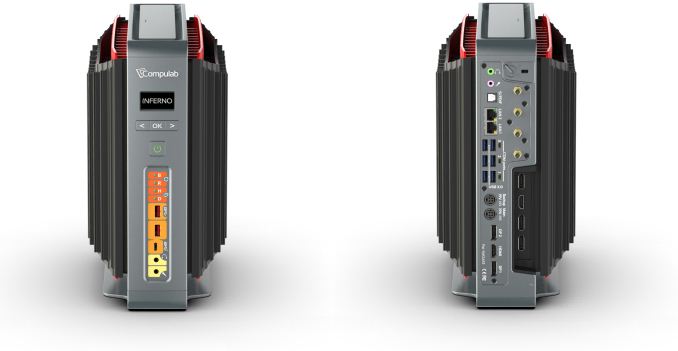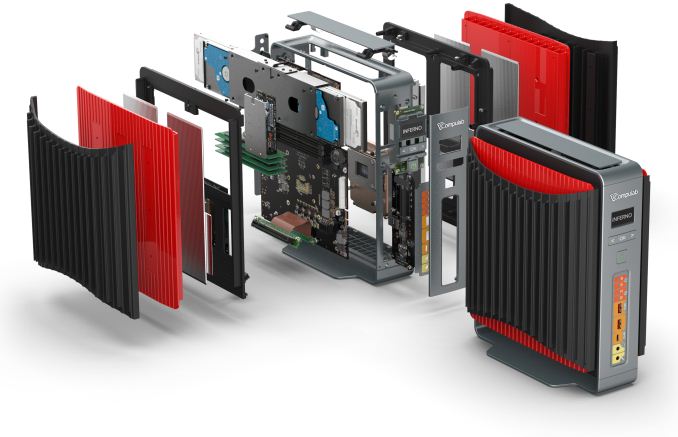Compulab Passively-Cooled Airtop2 Inferno with GeForce GTX 1080
by Anton Shilov on February 24, 2018 12:01 PM EST
Compulab has announced its first passively-cooled gaming desktop computer developed using the company’s expertise in fanless SFF systems. The Airtop2 Inferno uses an enhanced version of the Compulab’s proprietary natural air-flow (NAF) cooling system that can handle Intel’s Core i7-7700K processor as well as NVIDIA’s GeForce GTX 1080 graphics card. The Airtop2 Inferno will only be mass-produced if the company sees interest from the end user towards such systems.
Miniature gaming computers are certainly a part of an ongoing trend towards miniaturization of PCs in general — numerous manufacturers offer SFF gaming systems. Passively-cooled gaming PCs represent another category. Numerous companies have attempted to build such systems and/or produce appropriate components (e.g., Calyos, Zalman, etc.), but they were either very expensive, large, or had compromises when it comes to performance. Enter, Compulab. The company has been producing fanless special-purpose SFF PCs since 2007 and has experience with passive cooling. Compulab has been selling its specialized Airtop-branded fanless workstations for over two years now and this month it announces plans to expand its business to gaming systems. The first of such machines will be the Airtop2 Inferno that builds upon the workstation introduced earlier this month, but has an improved cooling system that can handle higher TDPs.
The Compulab Airtop2 Inferno relies on a specially-designed Intel C236-based motherboard and will be equipped with Intel’s Core i7-7700K processor as well as NVIDIA’s GeForce GTX 1080 graphics card. The system can be outfitted with up to 64 GB of DDR4-2400 memory, two M.2 NVMe SSDs and four 2.5”/9.5mm SATA storage devices. When it comes to I/O capabilities, the Airtop Inferno2 will have two USB 3.1 Gen 2 (USB-A and USB-C) ports (enabled by a FACE module), seven USB 3.0 headers, two GbE controllers, optional 802.11ac Wi-Fi, Bluetooth, audio connectors, DisplayPort 1.2 as well as HDMI outputs and so on. Since the Airtop2 Inferno relies on the Airtop2, it has almost the same connectivity capabilities as the fanless workstation, so it supports an optional 4G/LTE modem as well as FACE expansion modules.
The key difference between the Airtop2 and the Airtop2 Inferno is the enhanced natural air-flow (NAF) cooling technology capable of removing up to 300 W of heat. As discussed two years ago, the NAF heat-exchange system uses two special side-panels, each of which can dissipate heat. The side-panels are equipped with traditional flat copper heat-pipe arrays (with micro-channels) that take away heat from the hottest components (i.e., the CPU and the GPU) and spread it across the side-panel. The heat from the heat-pipe arrays is removed by the special air-tube panels consisting of 14 tubes with air inside. Once the air gets hot, it starts to rise up, removing heat from the side panels. The Airtop2 Inferno has side panels that feature additional aluminum tubes/heat spreaders that can dissipate more heat than the regular NAF panels and therefore handle TDP of Intel’s Core i7-7700K as well as NVIDIA’s GeForce GTX 1080. Compulab believes that the maximum TDP rating that the NAF Inferno cooling system can handle is 300 W, enough to keep the aforementioned CPU and GPU cool, but without overclocking.
| Compulab Airtop2 Inferno | ||||||
| General Specifications | ||||||
| CPU | Intel Core i7-7700K (4C/8T, 4.2/4.5 GHz) | |||||
| Chipset | Intel C236 SKL, KBL support, up to 20 PCIe 3.0 PCIe lanes x1, x2, x4 bifurcation RAID, vPro, TXT etc. |
|||||
| RAM | Up to 64 GB DDR4-2400 | |||||
| GPU | NVIDIA GeForce GTX 1080 8 GB Intel HD Graphics 630 |
|||||
| Storage | DFF | 4 × 2.5"/9.5mm SATA HDDs/SSDs or 2 × 2.5"/15mm SATA drives |
||||
| Modules | 2 × M.2-2280 PCIe NVMe SSDs 3 × M.2-22110 PCIe NVMe SSDs on backplane card installed instead of discrete graphics card |
|||||
| Expansion | PCIe x16 FACE Modules |
|||||
| Display Outputs | iGPU | 2 × DisplayPort 1.4 1 × HDMI 1.4 |
||||
| dGPU | 3 × DisplayPort 1.4 + 1 × HDMI 2.0b | |||||
| Networking | Wired | Dual GbE: Intel I219 + Intel I210 | ||||
| Wireless | 802.11ac, 2T2R, 2.4 GHz/5GHz Bluetooth 4.2 |
|||||
| WWAN | Optional M.2 B-key 3042 + 2×RP-SMA antennas modem with micro-SIM | |||||
| I/O | Front: 2 × USB 3.1 Gen 2 (USB-A, USB-C), 1 × USB 3.0 Back: 6 × USB 3.0, 3 × RS232 |
|||||
| Audio | Realtek ALC1150 audio codec with line-out, mic, S/PDIF | |||||
| Dimensions | 150 × 300 × 255 mm 5.9" × 11.8" × 10" |
|||||
| Volume | ? | |||||
| Operating System | Windows 10 | |||||
| FACE Modules | FM-AT2 | Built-in-self-test LED indicators | 2x USB 3.0 | audio | micro-SD | mini-PCIe | ||||
| FM-POE | 4x Gbit Ethernet with PoE (PSE) | 2x USB 2.0 | |||||
| FM-LANE4U4 | 4x Gbit Ethernet | 4x USB 2.0 | |||||
| FM-OPLN | 2x Optical Gbit Ethernet (SFP+) | 2x USB 2.0 | |||||
| FM-EBP | Gigabit Ethernet bypass | |||||
| FM-SER | 6x RS232 / RS485 | |||||
| FM-XTDM2 | 2x mini-PCIe | |||||
Compulab describes its Inferno as the Airtop2 on steroids. It is very similar, but uses a different processor, graphics card, cooling system, PSU and is equipped with a module that enables USB 3.1 Gen 2 connectivity. The company has finished development of the system, but needs to fabricate the extra passive cooling elements, for which it plans to run a special crowdfunding campaign. With all things go, Compulab intends to ship the system in June. The actual price of the Airtop2 Inferno will depend on exact configurations of RAM and storage, but expect starting price to be comparable with pricing of beefed-up Airtop2 workstation.
Compulab expects to start selling the Airtop2 Inferno direct from its website in a couple of months.
Related Reading
- Compulab Unveils Passively-Cooled Airtop2 SFF Workstation with Xeon E3 and Quadro
- Compulab Rolls-Out Passively-Cooled Airtop Systems
- Corsair ONE Gets Caffeinated: Now with Coffee Lake
- Intel's Hades Canyon NUCs with Radeon Graphics are Official: $799-$999, Shipping in Spring 2018
- Shuttle Unveils SZ270R9 SFF PC with ‘Turbo’ Button: Core i7, Long GPU, 6 Drives & More
- Shuttle Squeezes Desktop Graphics Card into a 3-Liter XH110G SFF PC Barebones
- Shuttle’s X1 Now Available: NUC-Like PC With a GeForce GTX 1060 GPU
Source: Compulab


















14 Comments
View All Comments
RaistlinZ - Saturday, February 24, 2018 - link
That actually looks really cool.Makaveli - Saturday, February 24, 2018 - link
Agreed I like it.qlum - Saturday, February 24, 2018 - link
It would have been much better however with a 8700k instead of 7700k as that is a pretty decent bump up in performance.jtd871 - Saturday, February 24, 2018 - link
And a pretty decent bump up in effective power draw and dissipation requirements under full multicore. That's why no 8700k.mukiex - Monday, February 26, 2018 - link
That does seem a bit odd, though, given that their current Airtop2, which features a smaller cooling unit, handles an i7 7700 just fine. It doesn't appear that the GPU and CPU cooling assemblies share any thermal load.You would think that the bump up in passive cooling that upgrades them from a GTX 1060 to a 1080 on the GPU side would be more than enough to upgrade them to an 8700 class chip on the CPU side. Maybe they assume that the extra work needed to add Kaby Lake support (which isn't trivial, mind you) would mostly be made up for by someone just overclocking their 7700? (the Airtop 2 is a non-K model)
stanleyipkiss - Saturday, February 24, 2018 - link
I would absolutely buy it if it were available in the EU right now.Lolimaster - Saturday, February 24, 2018 - link
Using an obsolete CPU.Would be better with a soldered Ryzen 5 1600X + 1080.
lazarpandar - Saturday, February 24, 2018 - link
obsolete is a bit harsh.. it's not the best but it's a fine procmobutu - Saturday, February 24, 2018 - link
superbdarkswordsman17 - Saturday, February 24, 2018 - link
That's a very appealing system and impressive at offering such cooling capability passively.I'm not crazy about the looks. On the workstation version a lot of people seemed to like them a lot, although it seems more people just wanting to complain about the excessive RGB lighting that is permeating so many computer products. Its not even that it looks bad to me, but feel like a simple more unified design would look a bit better (the black fin pieces over top of the red ones for instance. Maybe some other color options.
I'd also kinda like an actively cooled version, with fan(s) integrated into the base (maybe a single large one, or maybe 3 120mm fans, well integrated so they wouldn't be visible, and would be nearly inaudible. It'd give just a bit more headroom.
Maybe offer some extra services, like binning (in this case I'd say it'd focus more on undervolting performance, maybe have them work on optimal clockspeeds/voltage) and delidding. Another would be for them to build the system so they could use liquid metal TIM which could be very helpful for heat transfer off the chip. LTT had a video about that in a laptop and the results were impressive, and it'd be a lot easier if the system was built with it in mind for protection (like a protective shim/coating). Extra work/cost, but they could likely get people to pay for it depending on the results and actual cost.